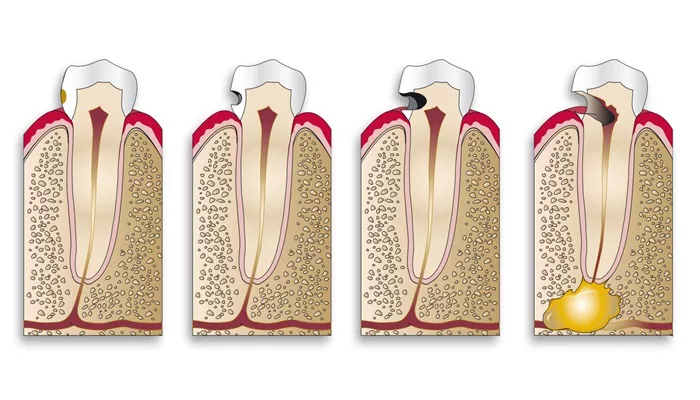Tooth decay, also known as dental caries or cavities, is a common dental issue that affects people of all ages. It occurs when the hard surface of the teeth, known as enamel, is damaged by acids produced by bacteria in the mouth. Understanding how tooth decay develops is crucial for prevention and maintaining good oral health. This article delves into the causes of tooth decay, the role of bacteria, dietary influences, and preventive measures.
What Is Tooth Decay?
Tooth decay is characterized by the gradual destruction of tooth enamel, which can lead to cavities. The process begins when bacteria in the mouth metabolize sugars and starches from food and drinks, producing acids as a byproduct. These acids attack the enamel, leading to its demineralization and eventual formation of cavities if not addressed promptly.
The Role of Bacteria in Tooth Decay
The mouth is home to millions of bacteria, some of which are beneficial while others can be harmful. The harmful bacteria primarily involved in tooth decay include Streptococcus mutans and Lactobacillus species. Here’s how they contribute to tooth decay:
Plaque Formation: When we consume food, especially those high in sugars and starches, these bacteria combine with food particles to form a sticky film called plaque. Plaque adheres to the teeth and can harden into tartar if not removed through regular brushing and flossing.
Acid Production: The bacteria in plaque metabolize sugars and produce acids that can erode enamel. This acid attack can lead to mineral loss from the enamel surface, weakening it over time.
Cavity Development: As the enamel continues to lose minerals due to repeated acid exposure, it may eventually break down completely, forming a cavity. Cavities can cause pain, infection, and even tooth loss if left untreated.
Factors Contributing to Tooth Decay
Several factors can increase the risk of developing tooth decay:
Poor Oral Hygiene: Inadequate brushing and flossing allow plaque to accumulate on teeth, increasing the likelihood of decay.
Diet High in Sugars and Acids: Frequent consumption of sugary snacks and beverages provides constant fuel for bacteria, leading to more acid production.
Insufficient Fluoride: Fluoride helps remineralize enamel and prevent cavities. Lack of fluoride from toothpaste or fluoridated water can make teeth more susceptible to decay.
Frequent Snacking: Snacking throughout the day increases acid exposure on teeth since bacteria continuously produce acid after each meal.
Dry Mouth: Saliva plays a vital role in neutralizing acids and washing away food particles. Conditions that reduce saliva flow can increase decay risk.
Worn Dental Work: Old fillings or dental devices may become rough or break down over time, making it easier for plaque to accumulate.
Receding Gums: Gum recession exposes tooth roots that are more prone to decay than enamel-covered areas.
Genetic Factors: Some individuals may be genetically predisposed to dental issues, including a higher risk for tooth decay.
The Process of Tooth Decay
Tooth decay develops through several stages:
Initial Exposure: When you eat or drink sugary foods, remnants remain in your mouth.
Plaque Formation: Bacteria feed on these sugars and form plaque on your teeth.
Acid Attack: The acids produced by bacteria begin to dissolve minerals from your enamel.
Demineralization: If demineralization continues without intervention, white spots may appear on teeth—an early sign of decay.
Cavity Formation: Eventually, if the process continues unchecked, cavities form as enamel is breached.
Prevention Strategies
Preventing tooth decay involves maintaining good oral hygiene practices and making informed dietary choices:
Regular Brushing and Flossing: Brush your teeth at least twice a day with fluoride toothpaste and floss daily to remove plaque buildup.
Limit Sugary Snacks and Drinks: Reduce the frequency of consuming sugary foods and beverages; opt for healthier snacks like fruits or vegetables instead.
Use Fluoride Products: Incorporate fluoride toothpaste into your routine and consider fluoride treatments from your dentist if necessary.
Stay Hydrated: Drink plenty of water throughout the day to help wash away food particles and neutralize acids in your mouth.
Regular Dental Visits: Schedule regular check-ups with your dentist for professional cleanings and early detection of any dental issues.
Conclusion
Tooth decay is a preventable condition that results from a combination of bacterial activity, poor oral hygiene, dietary habits, and other risk factors. By understanding how tooth decay occurs and implementing effective prevention strategies, individuals can significantly reduce their risk of developing cavities. Regular dental care combined with good oral hygiene practices is essential for maintaining healthy teeth throughout life.

